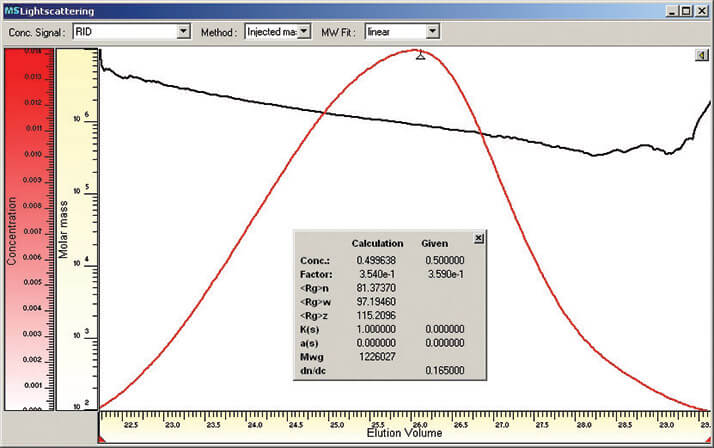GPC/SEC is the method of choice for measuring the molar mass distribution of hyaluronic acid. True molar masses can be obtained when on-line multi angle laser light scattering (MALLS) is used in combination with a refractive index detector. The refractive index increment (dn/dc) for light scattering data evaluation can be determined on-line, offline using dedicated instrumentation or taken from literature.
Eluent:
0.005M phosphate
buffered saline, 0.069 M NaCl
Columns:
3 x PSS SUPREMA
Lux 10 µm
Ultrahigh (8 x 300 mm) + precolumn
Data acquisition:
PSS WinGPC
UniChrom with Compliance Pack
Detectors:
SECcurity
GPC1260 RI
SECcurity MALLS
SLD7000
Flow-rate:
0.5 ml/min
Concentration:
0.5 g/l
Injection volume:
100 µl
High molar mass samples require lower flow-rates and concentrations in GPC/SEC. The GPC/SEC conditions and columns have been optimized for high molar mass hyaluronic acid with respect to loading, flow-rate and column particle size and porosity. For sample preparation the water content of approx. 12 % has been taken into account.
* Highest molar mass standard: Mp = 2 500 000 Da, P/N PSS-dpul2.5m

Due to the lack of high molar mass calibration standards the use of light scattering detection is recommended. This also allows the measurement of true molar masses. A refractive index increment (dn/dc) for hyaluronic acid of 0.165 ml/g has been used to evaluate the light scattering data.1 Figure 1 shows the slice concentration measured by the RI detector as well as the on-line measured molar mass. Sample recovery (comparing Concentration Calculation vs. Given) was nearly 100% showing that all material eluted from the column.
- Lavrenko, Linow, Gornitz in Analytical Ultracentrifugation in Biochemistry and Polymer Science 517-531 Royal Society of Chemistry, Cambridge (1992)





